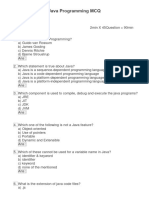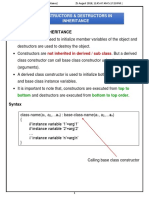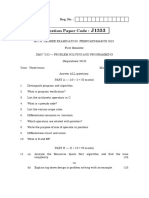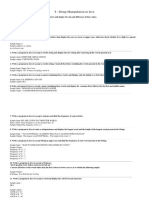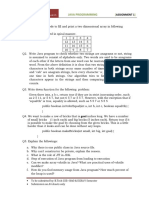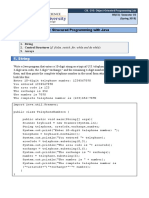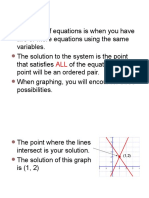CSc
2010, Fall 2013
Final Exam -‐ Practice Problems for Java n-‐ SOLUTIONS
MULTIPLE CHOICE QUESTIONS
(1) Which of the following reserved words in Java is used to create an instance of a
class?
a) class
b) public
c) public or private, either could be used
d) import
e) new
(2) If a method does not have a return statement, then
a) it will produce a syntax error when compiled
b) it must be a void method
c) it can not be called from outside the class that defined the method
d) it must be defined to be a public method
e) it must be an int, double, or String method
(3) What is the value of the String S after the following line?
String S = (new String("arach")).substring(0,2) +
(new String("nophobia")).substring(3);
(a) "arachobia"
(b) "arnophobia"
(c) "arhobia"
(d) "rachobia"
(4) The method twist is defined as follows:
public void twist(String[] w) {
String temp = w[0].substring(0, 1);
w[0] = w[1].substring(0, 1) + w[0].substring(1);
w[1] = temp + w[1].substring(1);
}
What is the output of the following code segment?
String[] words = {"HOW", "NEAT"};
twist(words):
System.out.println(words[0] + " " + words[1]);
(a) NOW NOW
(b) HOW HOW
(c) NOW HOW
(d) HOW NEAT
(e) NOW HEAT
(5) What is the output of the following code?
THIS TOPIC NOT COVERED IN CLASS – PLEASE IGNORE
String barb = "BARBARA";
scramble(barb);
System.out.println(barb);
The method scramble is defined as follows:
public static String scramble(String str) {
if (str.length() >= 2){
int n = str.length() / 2;
str = scramble(str.substring(n)) + str.substring(0, n);
}
return str;
}
(1) BARBARA
(b) ARBABAR
(c) AABAR
(d) ARBABARB
(e) ARABARBARB
(6) What are the values in arr after the following statements are executed?
int[] arr = {1, 1, 0, 0, 0};
for (int i = 2; i < arr.length; i++)
arr[i] = arr[i-1] + arr[i-2];
(a) 11011
(b) 11210
(c) 11222
(d) 11235
(e) 11248
(7) Given
double x = 5, y = 2;
What is the value of m after the following statement is executed?
int m = (int)(x + y + x / y - x * y - x / (10 * y));
(a) -‐1
(b) -‐0.75
(c) -‐0.5
(d) 0
(e) 1
(8) What is the value of sum after the following code segment is executed?
int p = 3, q = 1, sum = 0;
while (p <= 10) {
sum += p % q;
p++;
q++;
}
(a) 0
(b) 10
(c) 12
(d) 14
(e) 52
(9) Consider the following method:
THIS TOPIC NOT COVERED IN CLASS – PLEASE IGNORE
public int goFigure(int x) {
if (x < 100)
x = goFigure(x + 10);
return (x - 1);
}
What does goFigure(60) return?
(a) 59
(b) 69
(c) 95
(d) 99
(e) 109
(10) What are the values of m and n after the following code runs?
int m = 20, n = 2, temp;
for (int count = 1; count <= 20; count++) {
temp = m;
m = n + count;
n = temp - count;
}
(a) m = 230 n = -‐208
(b) m = 30 n = -‐8
(c) m = 12 n = -‐10
(d) m = -‐12 n = 8
(e) m = -‐190 n = 212
Show the EXACT output the following programs generate:
(1)
public class e21 {
public static void main (String args[]) {
int num = 4;
printNumbers(num);
}
private static void printNumbers(int n) {
for (int i=1; i <= n; i++) {
for (int k=1; k <= 2*(i-1)+1; k++)
System.out.print(i);
System.out.println();
}
}
}
1
222
33333
4444444
(2)
public class f5 {
public static void main(String args[]) {
int m=63,n=0;
for (;m>0; n++,m/=2);
System.out.println("n = " + n);
}
}
n = 6
PROGRAMS TO WRITE:
(1) Write a class method that takes as input a String object whose value is an English
sentence. The method should return the last word in the sentence. You may assume
that the sentence contains words separated by one space and the sentence
terminates with a period. For example the following would be a valid sentence:
"The cat ate the rat."
Make sure that the period at the end of the sentence is not included in the result that
is returned by the method.
private static String getLastWord(String str) {
str=str.substring(str.lastIndexOf(' ')+1, str.length()-1);
return str;
}
Write a main method that reads a sentence from the keyboard, calls the above
method to get the last word, and prints the last word to the screen.
public static void main(String[] args) {
Scanner sc = new Scanner(System.in);
System.out.println("Please enter a sentence: ");
String sentence = sc.nextLine();
System.out.println(getLastWord(sentence));
}
(2) Write a static method named vowelCount that accepts a String as a parameter
and produces and returns an array of integers representing the counts of each
vowel in the String. The array returned by your method should hold 5 elements: the
first is the count of A’s, the second is the count of E’s, the third I’s, the fourth O’s, and
the fifth U’s. Assume that the string contains no uppercase letters.
For example, the call
vowelCount("i think, therefore i am");
should return the array
{1, 3, 3, 1, 0}.
private static int[] vowelCount(String str) {
int[] arr = { 0, 0, 0, 0, 0 };
for (int i = 0; i < str.length(); i++)
if (str.charAt(i) == ‘a’)
arr[0]++;
else if (str.charAt(i) == ‘e’)
arr[1]++;
else if (str.charAt(i) == ‘i’)
arr[2]++;
else if (str.charAt(i) == ‘o’)
arr[3]++;
else if (str.charAt(i) == ‘u’)
arr[4]++;
return arr;
}
(3) Write a method named minGap that accepts an integer array as a parameter and
returns the minimum 'gap' between adjacent values in the array. The gap between
two adjacent values in a array is defined as the second value minus the first value.
For example, suppose a variable called array is an array of integers that stores the
following sequence of values.
int[] array = {1, 3, 6, 7, 12};
The first gap is 2 (3 -‐ 1), the second gap is 3 (6 -‐ 3), the third gap is 1 (7 -‐ 6) and the
fourth gap is 5 (12 -‐ 7). Thus, the call of minGap(array) should return 1 because
that is the smallest gap in the array. Notice that the minimum gap could be a
negative number. For example, if array stores the following sequence of values:
{3, 5, 11, 4, 8}
The gaps would be computed as 2 (5 -‐ 3), 6 (11 -‐ 5), -‐7 (4 -‐ 11), and 4 (8 -‐ 4). Of these
values, -‐7 is the smallest, so it would be returned.
This gap information can be helpful for determining other properties of the array.
For example, if the minimum gap is greater than or equal to 0, then you know the
array is in sorted (nondecreasing) order. If the gap is greater than 0, then you know
the array is both sorted and unique (strictly increasing).
If you are passed an array with fewer than 2 elements, you should return 0.
private static int minGap(int[] value) {
if (value.length < 2)
return 0;
int min = value[1]-value[0];
for(int i=1;i<value.length-1;i++)
if(min>value[i+1]-value[i])
min = value[i+1]-value[i];
return min;
}
(4) Write a method named toBinary that accepts an integer as a parameter and
returns a string of that number's representation in binary. For example, the call of
toBinary(42) should return "101010".
We will assume a positive parameter.
private static String toBinary(int num) {
if (num == 0)
return "0";
String str="";
while (num != 0) {
str = (num%2)+str;
num /= 2;
}
return str;
}




